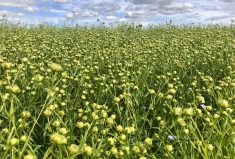Glacier FarmMedia—Spring planting in Saskatchewan moved into its final days as it advanced 17 points at 94 per cent complete as of June 3. Saskatchewan Agriculture noted that despite the speed seeding has been going it was a shade behind the five and 10-year averages of 97 per cent finished.
Helping things along was the rainfall that varied across the province. The areas around Porcupine Plain and Foam Lake received 73 to 83 millimeters, the department reported. That also improved Saskatchewan’s topsoil moisture levels, with four per cent rated as surplus, 91 per cent was adequate and four per cent was short.
Read Also

U.S. livestock: Feeder cattle hit contract highs on tight supply
Chicago | Reuters – All Chicago Mercantile Exchange feeder cattle futures and most live cattle futures hit contract highs on…
Field pea planting was virtually complete at 99 per cent, followed closely behind by lentils at 97 per cent. Meanwhile, chickpeas were a little further back at 90 per cent finished. Saskatchewan Ag said 18 per cent of the pulses were at the pre-emergent stage, with 68 per cent at the seedling stage and 14 per cent at the vegetative stage.
Of the cereals, spring wheat led at 96 per cent seeded, with durum a point back. Barley was next at 92 per cent complete, with oats at 88 per cent and triticale at 84 per cent. The department reported 26 per cent of spring cereals were at the pre-emergent stage, 57 per cent were at the seedling stage and 17 per cent were tillering.
As for the winter cereals, 48 per cent reached the tillering stage, with 25 per cent at stem elongation, 20 per cent at flag leaf and seven per cent were heading.
The oilseeds saw canary seed at 94 per cent finished with canola at 93 per cent, flax at 92 per cent and mustard at 87 per cent. Saskatchewan reported 43 per cent of the canola and mustard were at the pre-emergent stage, 54 per cent was at the seedling stage and three per cent at the rosette stage.
Regionally, planting reached 96 per cent complete in Saskatchewan’s southeast and southwest, with the northwest at 93 per cent done. A point behind that were the east-central, west-central and northeast regions of the province.
As seeding wound down, more producers were spraying their crops when the weather permitted.
In terms of damage, wind, frost and hail led to some minor issues. Flea beetles and cutworms were being dealt with while grasshoppers and gophers continued to be monitored.

















